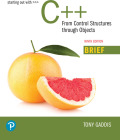
Regular “for” loop:
The “for” loop is also referred as count-controlled loop and it contains three processes as follows:
- Initialization
- Compare
- Update
It is possible to initialize more than one variable in loop expression. In some cases it is necessary to track number of times the loop gets executed; so C++ provides “for” loop.
Syntax:
The syntax for the “for” loop is as follows:
//for loop condition
for (initialization; compare; update)
{
//statement
}
In the above format,
- The “initialization” represents the initialization variable for the loop.
- The “compare” represents the comparison condition which is used to exit from the loop when the condition becomes failure.
- The “update” represents the counter variable to count each iteration in the loop.
- The “statement” represents the statements which are needs to be executed during the loop iteration.
Range based for loop:
The range based “for” loop is the one which iterates each element once from the array. On iteration, the loop copies element from the array to variable each time.
- For example, consider an array consists of six elements; so, the loop will iterate for 6 times to retrieve each element from the array.
Syntax:
The syntax for the range based “for” loop is as follows:
for(datatype rangeVariable: array)
Statement;
In the above format,
- The “datatype” is the data type followed by the range variable; the range variable uses the same data type as the array follows or else it follows a type to which the element of the array can be automatically converted.
- The “rangeVariable” is the name which receives the value from array for each loop iteration; this variable changes the value on each loop iteration like first, second and so on.
- The “array” represents the name of the array that the loop needs to operate; from this array, the loop iterates once for every element.
- The “statement” represents the statement that needs to be executed during the loop iteration.
- Start the program
- Declare the variable “name” as “int” and assign the size of the variable “name” with 20 elements.
- Then, write the regular “for” loop and range based for loop to print each element of the array.
Want to see the full answer?
Check out a sample textbook solution
Chapter 7 Solutions
EBK STARTING OUT WITH C++
- using r language Obtain a bootstrap t confidence interval estimate for the correlation statistic in Example 8.2 (law data in bootstrap).arrow_forwardusing r language Compute a jackknife estimate of the bias and the standard error of the correlation statistic in Example 8.2.arrow_forwardusing r languagearrow_forward
- using r languagearrow_forwardThe assignment here is to write an app using a database named CIT321 with a collection named students; we will provide a CSV file of the data. You need to use Vue.js to display 2 pages. You should know that this assignment is similar, all too similar in fact, to the cars4sale2 example in the lecture notes for Vue.js 2. You should study that program first. If you figure out cars4sale2, then program 6 will be extremely straightforward. It is not my intent do drop a ton of new material here in the last few days of class. The database contains 51 documents. The first rows of the CSV file look like this: sid last_name 1 Astaire first_name Humphrey CIT major hrs_attempted gpa_points 10 34 2 Bacall Katharine EET 40 128 3 Bergman Bette EET 42 97 4 Bogart Cary CIT 11 33 5 Brando James WEB 59 183 6 Cagney Marlon CIT 13 40 GPA is calculated as gpa_points divided by hrs_attempted. GPA points would have been arrived at by adding 4 points for each credit hour of A, 3 points for each credit hour of…arrow_forwardI need help to solve the following case, thank youarrow_forward
- You will write a program that allows the user to keep track of college locations and details about each location. To begin you will create a College python class that keeps track of the csollege's unique id number, name, address, phone number, maximum students, and average tuition cost. Once you have built the College class, you will write a program that stores College objects in a dictionary while using the College's unique id number as the key. The program should display a menu in this order that lets the user: 1) Add a new College 2) Look up a College 4) Delete an existing College 5) Change an existing College's name, address, phone number, maximum guests, and average tuition cost. 6) Exit the programarrow_forwardShow all the workarrow_forwardConstruct a frequency polygon density estimate for the sample in Question 1, using bin width determined by Sturges’ Rule.arrow_forward
- Programming Logic & Design ComprehensiveComputer ScienceISBN:9781337669405Author:FARRELLPublisher:Cengage
 Programming with Microsoft Visual Basic 2017Computer ScienceISBN:9781337102124Author:Diane ZakPublisher:Cengage Learning
Programming with Microsoft Visual Basic 2017Computer ScienceISBN:9781337102124Author:Diane ZakPublisher:Cengage Learning EBK JAVA PROGRAMMINGComputer ScienceISBN:9781337671385Author:FARRELLPublisher:CENGAGE LEARNING - CONSIGNMENT
EBK JAVA PROGRAMMINGComputer ScienceISBN:9781337671385Author:FARRELLPublisher:CENGAGE LEARNING - CONSIGNMENT  C++ for Engineers and ScientistsComputer ScienceISBN:9781133187844Author:Bronson, Gary J.Publisher:Course Technology Ptr
C++ for Engineers and ScientistsComputer ScienceISBN:9781133187844Author:Bronson, Gary J.Publisher:Course Technology Ptr Microsoft Visual C#Computer ScienceISBN:9781337102100Author:Joyce, Farrell.Publisher:Cengage Learning,
Microsoft Visual C#Computer ScienceISBN:9781337102100Author:Joyce, Farrell.Publisher:Cengage Learning, C++ Programming: From Problem Analysis to Program...Computer ScienceISBN:9781337102087Author:D. S. MalikPublisher:Cengage Learning
C++ Programming: From Problem Analysis to Program...Computer ScienceISBN:9781337102087Author:D. S. MalikPublisher:Cengage Learning





